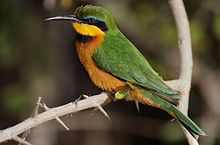- Little Bee-eater
-
Little Bee-eater 
At Buffalo Springs National Park, Kenya Conservation status Scientific classification Kingdom: Animalia Phylum: Chordata Class: Aves Order: Coraciiformes Family: Meropidae Genus: Merops Species: M. pusillus Binomial name Merops pusillus
Statius Muller, 1776The little Bee-eater, Merops pusillus is a near passerine bird in the bee-eater family Meropidae. It is resident in much of sub-Saharan Africa. It should not be confused with the Little Green Bee-eater, Merops orientalis. Migration is limited to seasonal movements depending on rainfall patterns.
This species, like other bee-eaters, is a richly coloured, slender bird. It has green upper parts, yellow throat, black gorget, and rich brown upper breast fading to buffish ocre on the belly. The wings are green and brown, and the beak is black. It reaches a length of 15-17 cm, which makes it the smallest African bee-eater. Sexes are alike. Often silent, their call is a soft "seep".
This is an abundant and tame bird, familiar throughout its range. There have been estimated to be between 60-80 million Little Bee-eaters. It breeds in open country with bushes, preferably near water. Just as the name suggests, bee-eaters predominantly eat insects, especially bees, wasps and hornets, which are caught in the air by sorties from an open perch. This species often hunts from low perches, maybe only a metre or less high. Before eating its meal, a bee-eater removes the sting by repeatedly hitting the insect on a hard surface.
Unlike most bee-eaters, these are solitary nesters, making a tunnel in sandy banks, or sometimes in the entrance to an Aardvark den. They lay 4 to 6 spherical white eggs. Both the male and the female take care of the eggs. These birds roost communally, lined up on a tree branch.
Various views and plumages
References
- BirdLife International (2004). Merops pusillus. 2006. IUCN Red List of Threatened Species. IUCN 2006. www.iucnredlist.org. Retrieved on 10 May 2006. Database entry includes justification for why this species is of least concern
- Kingfishers, Bee-eaters and Rollers by Fry, Fry and Harris, ISBN 0-7136-8028-8
- The Hamlyn photographic guide to birds of the world, foreword by Christopher Perrins; general editor: Andrew Gosler, London : Hamlyn, 1991, ISBN 0-600-57239-0
Bee-eaters (family: Meropidae) Genus SpeciesNyctyornis Meropogon Merops Little Bee-eater • Blue-cheeked Bee-eater • Green Bee-eater • White-throated Bee-eater • Swallow-tailed Bee-eater • Blue-tailed Bee-eater • Black Bee-eater • Blue-headed Bee-eater • Red-throated Bee-eater • White-fronted Bee-eater • Blue-breasted Bee-eater • Cinnamon-chested Bee-eater • Black-headed Bee-eater • Somali Bee-eater • Böhm's Bee-eater • Blue-throated Bee-eater • Olive Bee-eater • Rainbow Bee-eater • European Bee-eater • Chestnut-headed Bee-eater • Rosy Bee-eater • Northern Carmine Bee-eater • Southern Carmine Bee-eaterCategories:- IUCN Red List least concern species
- Meropidae
- Birds of Africa
Wikimedia Foundation. 2010.






